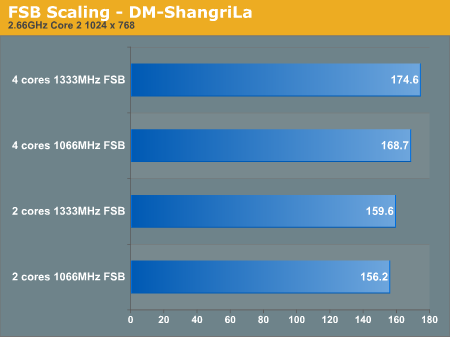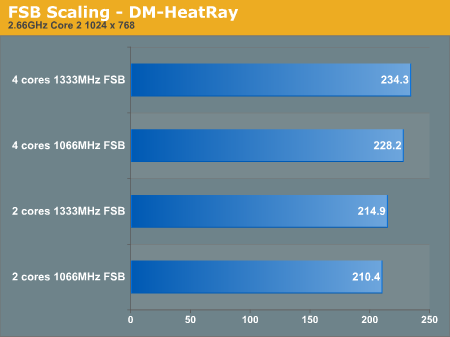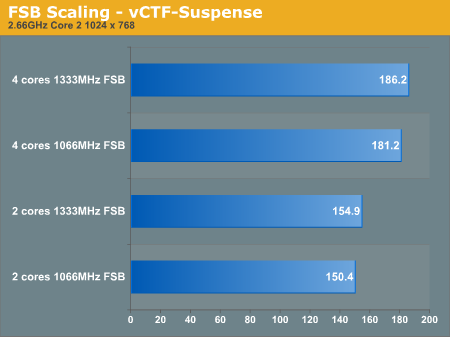Unreal Tournament 3 CPU & High End GPU Analysis: Next-Gen Gaming Explored
by Anand Lal Shimpi & Derek Wilson on October 17, 2007 3:35 AM EST- Posted in
- GPUs
FSB Scaling: 1066MHz, 1333MHz
It's not all about on-die cache with UT3; we wanted to see if the L2 cache dependency also extended to needing a fast memory subsystem as well. Intel's Core 2 CPUs still rely on an aging front side bus to make the journey out to main memory, so we toyed with increasing the FSB from 1066MHz up to 1333MHz to see how large of an impact existed on UT3.
Our original investigations into FSB performance showed that the move to 1333MHz wasn't a big deal, yielding low single-digit performance improvements in our usual tests.



Unreal Tournament 3 appears to be no different, even with four cores consuming data at 2.66GHz we're looking at a 3% increase in performance on average. The 1333MHz FSB isn't really necessary, while it would make more of a difference at smaller cache sizes, Intel just doesn't offer CPUs with small caches and 1333MHz FSBs.
Large caches? Absolutely. Faster FSB? Not necessary.










72 Comments
View All Comments
decalpha - Wednesday, October 17, 2007 - link
Why not compare the CPUs with similar cache size, since Athlon 64 X2 6000 has 2MB cache whereas the Core 2 Duo E6850 has 4MB and cache size does seem to matter.drebo - Wednesday, October 17, 2007 - link
I think it's even more relevant to point out that clock-for-clock comparisons have been worthless for a very long time, and only seem to have come back on this site now that Intel has a more efficient pipeline.PrinceGaz - Wednesday, October 17, 2007 - link
The X2 6000+ actually has 2x 1MB cache, which in most cases is worse than 2MB shared, so the cache situation is even worse for AMD in the comparison that was performed.drebo - Thursday, October 18, 2007 - link
Well, cache size in general is less important for AMD processors, as the path from CPU to RAM is much, much quicker. It would be interesting (and very, very difficult to gauge) what the difference would be. This is most likely why they left AMD off of the cache comparison charts. It's impossible, due to far too dissimilar architectures, to isolate ONLY the memory subsystems, which is what a cache comparison would be attempting to do.Cache misses on an Intel architecture are far more expensive than on AMD's architecture. But, without otherwise identical chips, there's simply no way to make a comparison.
bloc - Wednesday, October 17, 2007 - link
I think if you compared the 8600 gts and x2600 xt, the perf would be pretty close, with the x2600 xt being $50 cheaper.The architecture is there. Some games like cod4 hasn't taken advantage of it yet.
ImmortalZ - Wednesday, October 17, 2007 - link
The second set of graphs on page 3 seem to be all confused. Mixed up title text?Also, regarding the ATI midrange part, surely you guys have heard about the 2900PRO?
JarredWalton - Wednesday, October 17, 2007 - link
P3 graphs fixed. I'd imagine trying to get a 2900 Pro for testing is proving more difficult than anticipated. I know looking online that the few places I've seen that list them are out of stock.ImmortalZ - Wednesday, October 17, 2007 - link
Well, it's easy to test a 2900PRO. Underclock a 2900XT to 600Mhz core and 1600Mhz memory and test away! :D (there are 512MB GDDR3 and 1GB GDDR4 versions, so...). Just change the price from 389.99 to 249.99 for the 512MB and 319.99 for the 1GB.Of course, I'd personally wait for the 2950s to show up - single slot coolers are teh win :P
Bremen7000 - Wednesday, October 17, 2007 - link
What about the page 6 graphs? Am I missing something or are they lacking something?RobberBaron - Wednesday, October 17, 2007 - link
Second that. The second set of charts on page 6 is Intel CPu's only. Little confusing